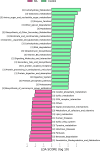Alterations of gut microbiota in infants with biliary atresia identified by 16S rRNA-sequencing
- PMID: 38355416
- PMCID: PMC10865691
- DOI: 10.1186/s12887-024-04582-9
Alterations of gut microbiota in infants with biliary atresia identified by 16S rRNA-sequencing
Abstract
Background: Biliary atresia (BA) is a severe neonatal disease with progressive intra- and extra-hepatic bile ducts inflammation and hepatic fibrosis. Characterization of gut microbiome profiles in infants with biliary atresia can provide valuable information and potential disease biomarkers. Our study aims to explore the relationship between gut microbiota and biliary atresia.
Methods: 16 S ribosomal RNA (rRNA) gene sequencing was carried out to identify the differences in composition and diversity of gut microbiota between infants with BA and healthy subjects. A total of 31 infants with biliary atresia and 20 healthy subjects were recruited.
Results: The composition of gut microbiota in BA group was significantly different with the normal control group (P < 0.05) and the abundance ratio of Klebsiella/Bifidobacterium showed great potential for identification of BA (P < 0.01). In addition, the differential bacterial taxa were involved in lipid and vitamins metabolism.
Conclusion: Our results could provide potential non-invasive biomarker for identification of biliary atresia and contribute to the treatment in terms of ameliorating microbiota dysbiosis.
Keywords: 16S rRNA-sequencing; Biliary atresia; Biomarker; Gut microbiota; Infant.
© 2024. The Author(s).
Conflict of interest statement
The authors declare no competing interests.
Figures





Similar articles
-
Association of gut microbiota and gut metabolites and adverse outcomes in biliary atresia: A longitudinal prospective study.Hepatol Commun. 2024 Oct 17;8(11):e0550. doi: 10.1097/HC9.0000000000000550. eCollection 2024 Nov 1. Hepatol Commun. 2024. PMID: 39761011 Free PMC article.
-
Analysis of gut microecological characteristics and differences between children with biliary atresia and non-biliary atresia in infantile cholestasis.Front Cell Infect Microbiol. 2024 Jun 13;14:1402329. doi: 10.3389/fcimb.2024.1402329. eCollection 2024. Front Cell Infect Microbiol. 2024. PMID: 38947125 Free PMC article.
-
Gut microbial profile in biliary atresia: a case-control study.J Gastroenterol Hepatol. 2020 Feb;35(2):334-342. doi: 10.1111/jgh.14777. Epub 2019 Aug 1. J Gastroenterol Hepatol. 2020. PMID: 31271681
-
Biliary atresia: the role of gut microbiome, and microbial metabolites.Front Cell Infect Microbiol. 2024 Jul 22;14:1411843. doi: 10.3389/fcimb.2024.1411843. eCollection 2024. Front Cell Infect Microbiol. 2024. PMID: 39104854 Free PMC article. Review.
-
Meta-analysis of 16S rRNA microbial data identified alterations of the gut microbiota in COVID-19 patients during the acute and recovery phases.BMC Microbiol. 2022 Nov 14;22(1):274. doi: 10.1186/s12866-022-02686-9. BMC Microbiol. 2022. PMID: 36376804 Free PMC article.
References
-
- Jiang H, Gao P, Chen H, Zhong Z, Shu M, Zhang Z, et al. The prognostic value of CD8 + and CD45RO + T cells infiltration and Beclin1 expression levels for early postoperative cholangitis of biliary atresia patients after Kasai operation. J Korean Med Sci. 2018;33:e198. doi: 10.3346/jkms.2018.33.e198. - DOI - PMC - PubMed
-
- Gad EH, Kamel Y, Salem TA, Ali MA, Sallam AN. Short- and long-term outcomes after Kasai operation for type III biliary atresia: twenty years of experience in a single tertiary Egyptian center-A retrospective cohort study. Ann Med Surg. 2021;62:302–14. doi: 10.1016/j.amsu.2021.01.052. - DOI - PMC - PubMed
MeSH terms
Substances
Grants and funding
LinkOut - more resources
Full Text Sources

